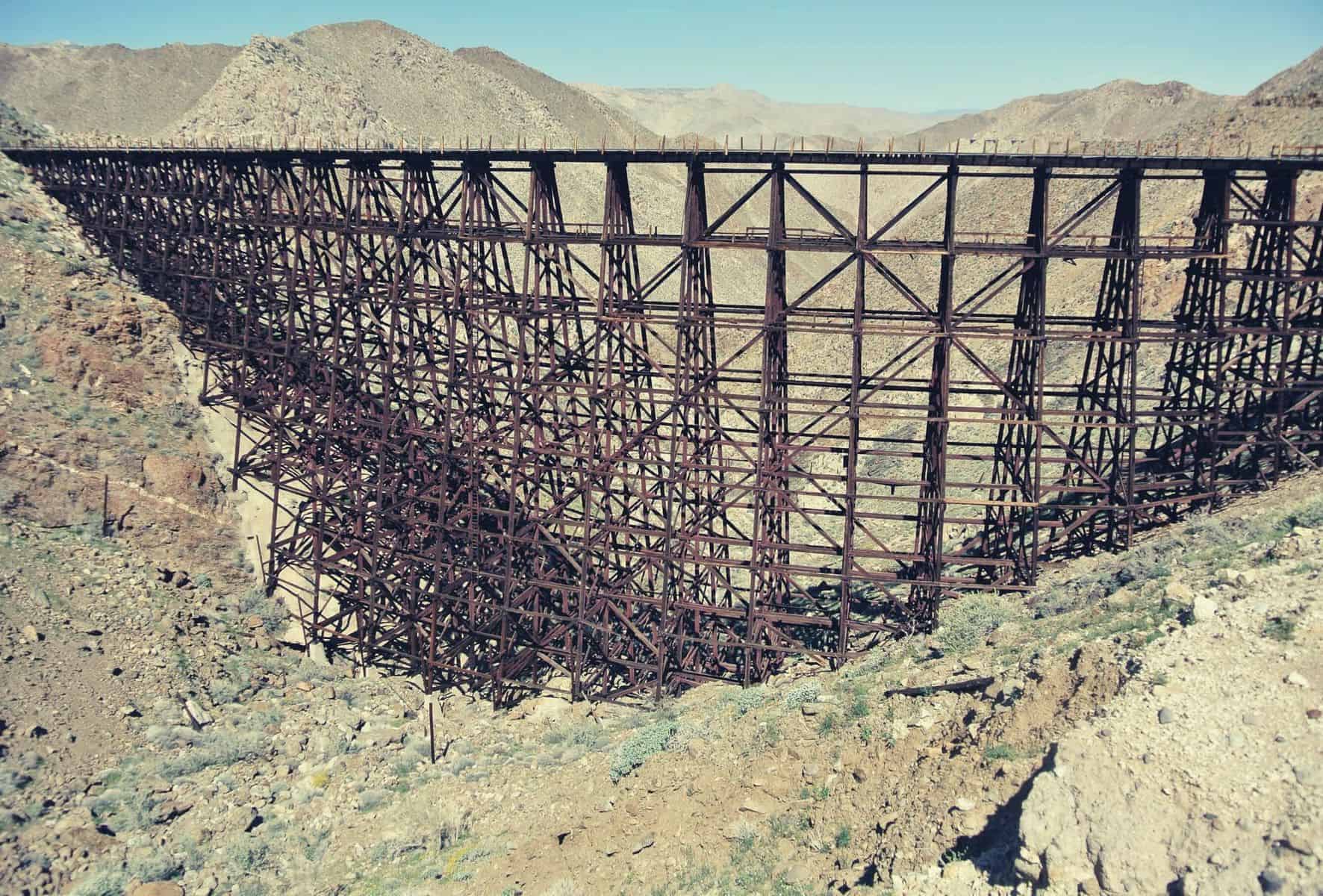Keen to mix things up with a ‘wildcard’ day away from manicured, well-signed, mellow trails that fail to scare the life out of you? Southern California’s Goat Canyon may just be the answer.
This trail is one that invokes the spirit of the true adventurer, cutting a bold line across one of Anza-Borrego Desert State Park’s more barren, lonely stretches of wilderness before plunging down a steep canyon wall into what seems to be another century. To hikers, budding geologists, fossil hunters, and history buffs alike it’s a backcountry curio that delivers as much in 4.6 miles as many other trails do in 100.
It’s no walk in the park, to be sure, but the rewards for your efforts include a sighting of the largest wooden trestle bridge on the planet, a true test of your physical and mental mettle, and a captivating desert environment in which you expect to see John Wayne (or at least Butch Cassidy and the Sundance Kid) at every turn in the stark, undulating terrain.
In this article we’re going to give you the lowdown on all you need to know when visiting the Goat Canyon, starting off with an overview of the area’s geology, history, and a few pre-trip tips before getting down to the nitty-gritty of the hike itself.
Table of Contents
RELATED READING: If you want to do some more hiking in the area, then check out our guide to the best Sacramento hikes.
Overview
Intro
Wild, scenic, sun-dappled, and far from the madding crowds — what else could you ask for? Well, in addition to posing a stiff hiking challenge and all of the above, the Goat Canyon Trestle hike also packs a wealth of historical intrigue, a fascinating geological profile, and a surprising variety of flora and fauna.
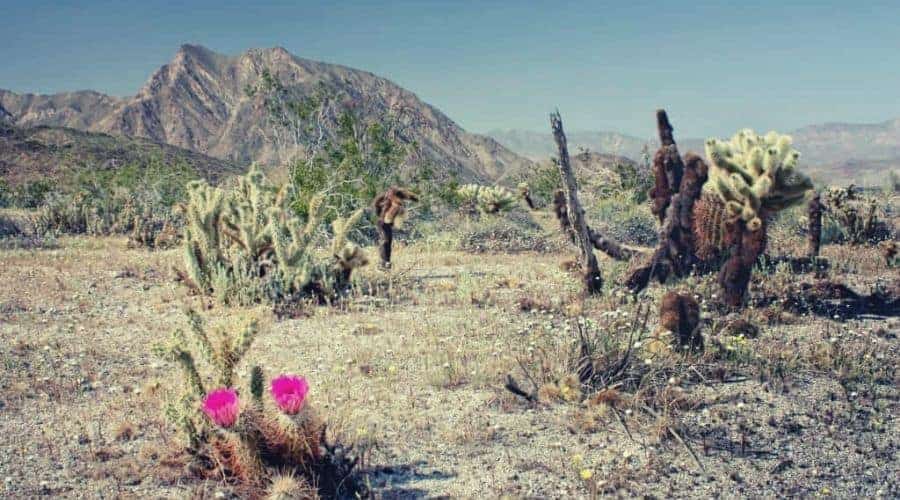
Geography and Geology
The Anza-Borrego region is something of a mecca for fossil hunters, paleontologists, and geologists alike.
While out on the Goat Canyon Trestle Trail, you may come across marine life fossils of critters that swam in the now non-existent Imperial Sea some 5 million years ago. If you don’t happen to spot any of these, you can’t fail to miss the pale strata of gneiss and granite streaking the otherwise russet-hued landscape, or the area’s numerous plunging basins and timeworn peaks.
All of the above are the offspring of the curious interplay between converging tectonic plate boundaries which developed the region’s geological backbone around 30 million years ago and continue to shape its features to this day.
History
All About the Bridge
One look at the terrain and you’ll quickly understand why the Carrizo Gorge track quickly earned the moniker of the “Impossible Railroad” when construction began in the early 1900s.
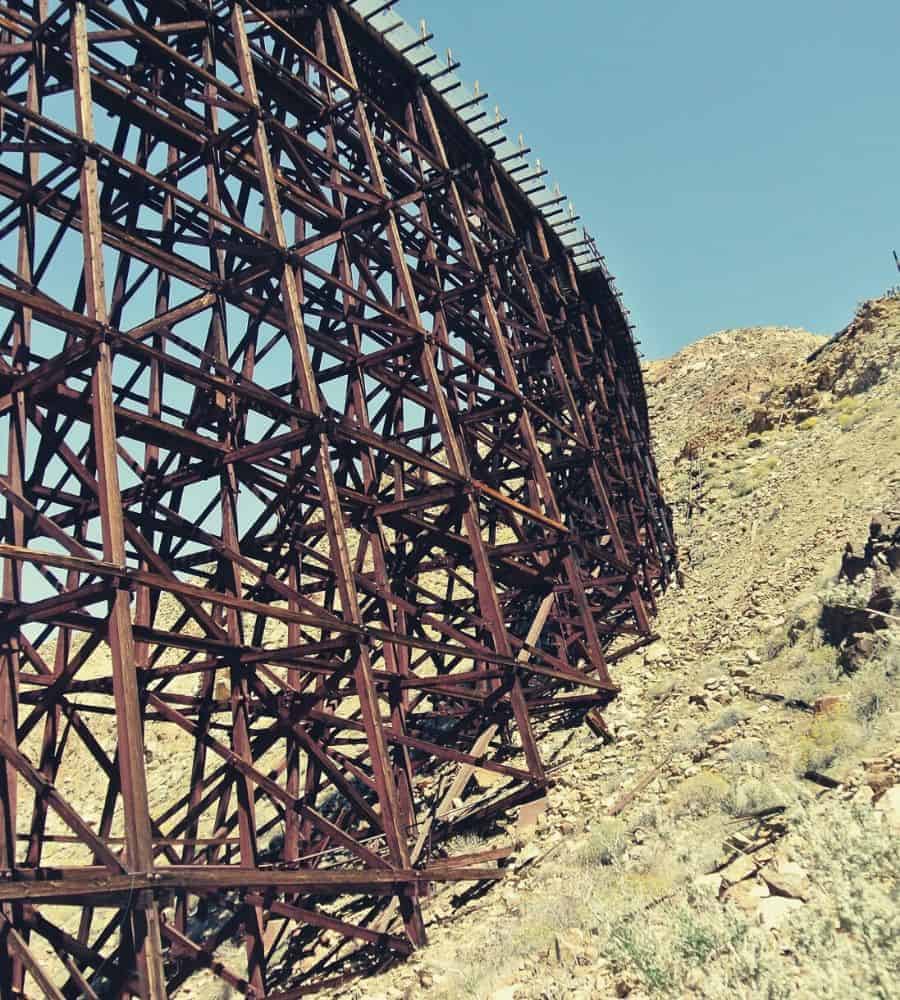
This segment of the San Diego and Arizona Eastern Railway in the southern Anza-Borrego wilderness would require no fewer than 17 tunnels, 15 wooden trestles, and a total of 12 years to complete. When the final spike was driven in by owner John D. Spreckels on November 15th, 1919, the track was widely heralded as one of the most audacious and impressive feats of engineering in the US.
The piece de resistance of the railroad is undoubtedly the Goat Canyon Trestle Bridge, a 600ft long wooden wonder spanning the breadth of the canyon at a height of up to 180ft. Even in today’s world of ever more awe-inspiring structural sensations, it’s hard not to marvel at the ingenuity and vision that must have gone into such an elaborate and audacious undertaking.
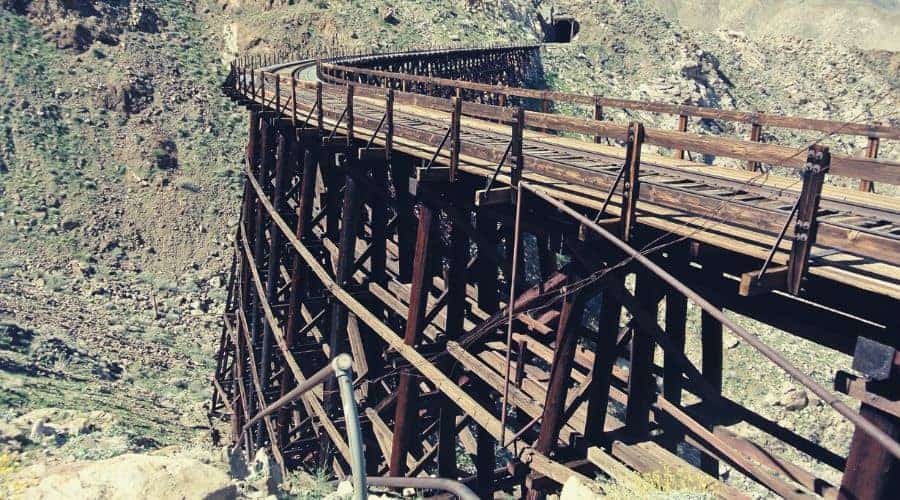
The railway closed down to the public in 1951 and then to freight traffic in 1983, but today is property of San Diego’s Metropolitan Transit System and leased out to the Baja California Railroad via the Imperial Gorge Railway, which is currently in the process of attempting to reopen the line. Should they succeed, the Impossible Railroad will become a trade route for goods passing between California and Mexico.
Bigfoot, Cults, Aliens, and a Sandman or Two
No remote historical area would be complete without a spooky story or two, would it? The area around the Goat Canyon Trestle obliges us with dozens, offering a rich mix of alien encounters, bigfoot sightings, and reports of a local sandman-cum-sasquatch prone to using public lavatories. The video below, best taken with a pinch of salt, provides an overview.
Ecology and Wildlife
As barren as the Goat Canyon Trestle hiking trail may seem at first glance, a surprising number of wildflowers and desert-dwelling animals can be found surviving and thriving in this particularly rugged portion of the Jacunda Mountains.
Some of the fauna you might encounter en route are the bighorn sheep, mule deer, coyote, bobcat, kit fox, black-tailed jackrabbit, antelope squirrel, kangaroo rat, and — drumroll — maybe even a mountain lion.
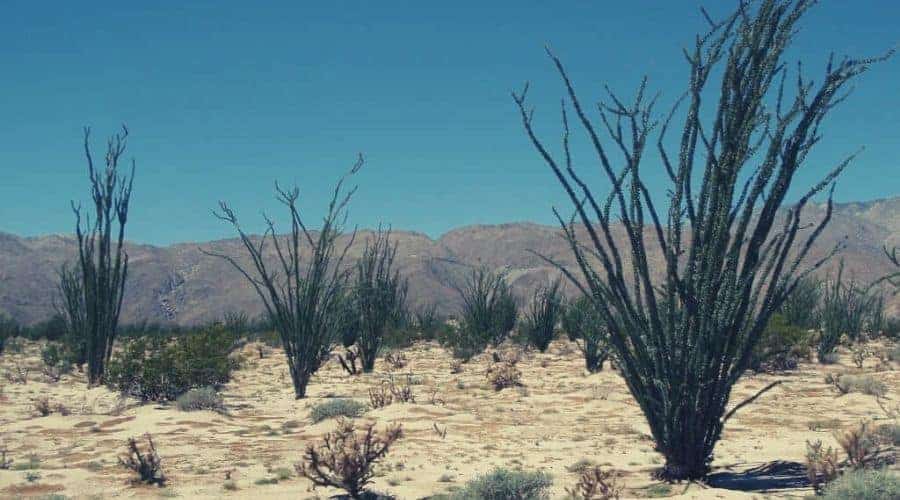
Flora-wise, the potential encounters are just as varied and numerous. In spring and early summer in particular, unlikely spatters of color adorn the tawny ochre spread of desert covered along the trail. Some of these include various cacti types (barrel, beavertail, cholla, prickly pear), desert fivespot, desert threadplant, stream orchid, ghost flower, desert agave, chuparosa, creosote, brittlebush, California fuchsia, and slender wreathplant.
Type of Trail and Trail Difficulty
Strenuous/Challenging: although it’s a short hike (4.6 miles return), the terrain is very tricky in places and there is no established trail to speak of. A few rock cairns dot the route above the trestle, but many of these veer off in random diversions and can’t be relied on. A GPS or map and compass skills, therefore, are all but essential.
Planning
Best Time to Hike the Trail
The trail is doable year-round, but in mid-summer, the heat can be ferocious (upwards of 100F) and shade a rarity until you reach the railway tunnels (which, as we’ll cover below, we’re technically not allowed to be in anyway!). For the best hiking conditions, we’d recommend heading to Goat Canyon in March, April, October, or November.
Hiking the trail after rainfall can make the short scrambling sections tricky and also clog the stretch of the off-road track to the trailhead. As no permits are required for the trail, we’d suggest postponing your hike until drier weather arrives.
Trailheads
Mortero Palms Trailhead, San Diego County, CA.
From Orange County, head east on the I-8 until reaching the hamlet of Ocotillo and signs for Imperial Highway. Turn left onto Imperial Highway and continue north until you see a small sign on the left for Mortero Wash. From here, a fairly rough off-road trail leads through Mortero Wash towards Dos Cabezas and reaches the trailhead after 7 miles. We don’t recommend trying this last section of off-road driving in a low-clearance vehicle.
Carrizo Gorge Road Trailhead
From Orange County, head east on the I-8 for just over 50 miles, then exit at Jacumba Hot Springs. After the exit, take a right onto Carrizo Gorge Road and continue to De Anza Springs Resort. From the resort, the rail track lies just to the left. You can park either inside the resort (paying a $5 per person charge and leaving your details) or just outside the gates for free.
Shuttle/transportation
No public transportation currently serves the Mortero Palms trailhead.
Trail Routes
From Mortero Trailhead — 5.5 Miles, Challenging, 4 hours return (2,200ft elevation gain)
From the Mortero Palms Trailhead, head north-northwest up the Mortero Wash, first on flat ground and then on a boulder-strewn slope. At the top of this slope, you will reach the saddle of the ridge that leads back up and over into another wash. Bearing west, a very discreet trail ascends gently to a flat area and then a more noticeable trail that branches off towards Goat Canyon.
The final stretch of the Mortero Wash leads over a low pass, after which the seriously scenic views open out before you. About a third of a mile further on, the trail begins its descent into Goat Canyon.
From the start of the relatively gentle descent into Goat Canyon only a mile remains to the trestle itself, but it’s the trickiest mile of the hike and requires a spot of boulder-hopping, slogging through brush and, finally, negotiating a steep dry gulch topped by an even steeper, dried-up waterfall.
At this point the views out to the trestle are outstanding; the views down the way are rather intimidating.
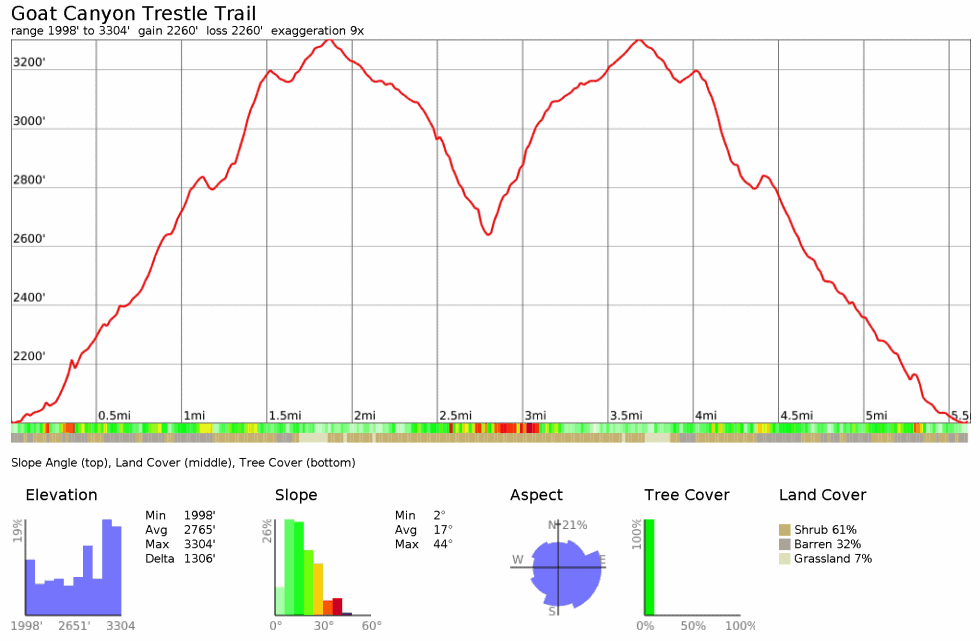
If you happen to have a rope handy or b***s of steel, you can abseil or free-climb down the dry waterfall. (We wouldn’t recommend it!) Otherwise, veer slightly south to descend a steep scree and dirt slope to the side of the near-vertical rock, still taking care to avoid any slips on the crumbly rock.
From the bottom of this slope, the way ahead is self-explanatory. It involves traversing sections of loose scree and is again quite steep, but doesn’t present anything too hairy if you take care with your footing.
All that remains is to admire the trestle, explore the disused machinery and tunnels, and marvel at the audacity of those who pioneered this simply breathtaking railroad — taking care, of course, to stay that obligatory 15ft away from the tracks and to save enough steam for the return journey.
Carrizo Gorge Road Trailhead — 18 miles, Easy, 7-8 hours
From the De Anza Springs Resort, the trail to the trestle is wonderfully simple, if not without a few surprises along the way.
This route follows the railroad all the way from the resort to the trestle itself, making it all but impossible to get lost. Along the way, however, you will see a handful of other trestles, pass through ten tunnels, see two disused train yards, and spot a number of abandoned pieces of railway machinery. It’s longer than the standard route from the Mortero Trailhead, but also much easier going.
Good to Know
Disclaimer and Counter-disclaimer
Disclaimer
There are two ways to reach the Goat Canyon Trestle, both of which involve walking on or in the vicinity of the railway line. While this adds to the hike’s appeal for some, it is technically illegal in the State of California to hike on or within 15 feet of a railway line and you could be cited for trespassing.
There are, moreover, reports of Homeland Security members training in the area and hikers being arrested for hiking on the railway line. While hiking on the railway line is optional in our featured trail (from the Mortero Trailhead), the alternative trail from De Anza Springs requires passing through tunnels and, hence, breaking the law.
The hike from Mortero Trailhead is not a straightforward outing and involves a number of risks and objective dangers. In order to do this hike safely, you should carry and know how to use a map and compass or GPS device, and also how to navigate with no trail and no reliable trail markers. This hike is also strenuous and involves a short section of scrambling and/or down-climbing on scree with significant exposure.
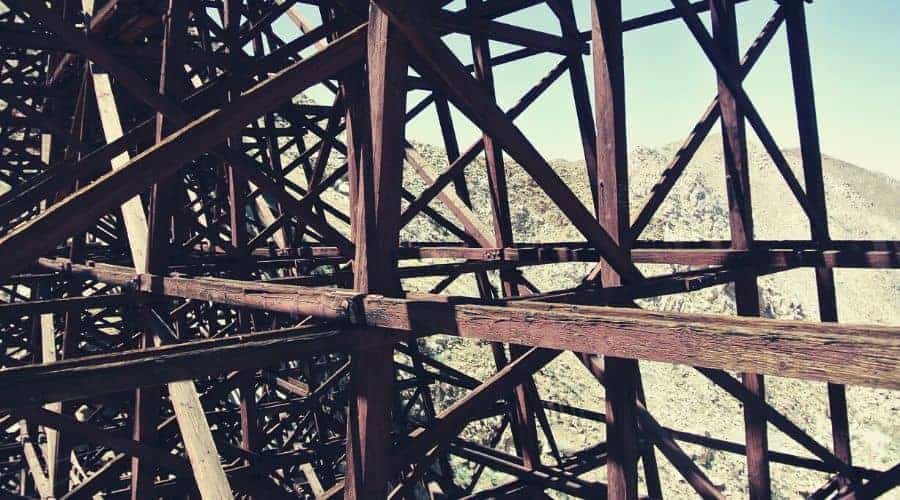
Another point worth noting is that there is no reliable water source on the route and no phone signal. Finally, reaching the trailhead requires negotiating a 7-mile stretch of off-road driving. While this is easily done in most 4x4s, it becomes tricky after heavy rainfall and is not recommended for low-clearance vehicles.
Counter-disclaimer
To avoid any legal issues on this hike, hikers can simply take the standard route from Mortero Trailhead as opposed to the longer route from De Anza Springs, thus eliminating the necessity of hiking through tunnels or along the tracks to reach the trestle. As long as you stay more than 15ft from the railway line, you’re unlikely to find yourself on any ‘WANTED’ hoardings after your hike.
Some would-be visitors are put off the Mortero Trailhead route by the prospect of the steep descent/ascent at the top of Goat Canyon, but this section is not prohibitive and easily doable by relative novices as long as you take care and veer right of the dried-up waterfall until finding a safer line of descent.
Suggested Gear List
- Map and compass
- GPS device
- Sun hat
- Sunscreen
- 3 liters of water per person (absolute minimum)
- First aid kit
- Season-appropriate clothing
- Daypack
- Food
- Hiking boots
Additional Resources
- Color recreation map of the area
- Falcon Guide book to hiking in Anza-Borrego Desert State Park
- Waterproof San Diego Backcountry map
